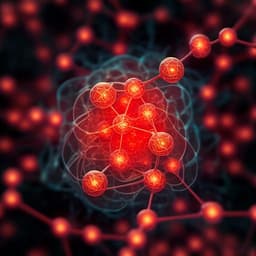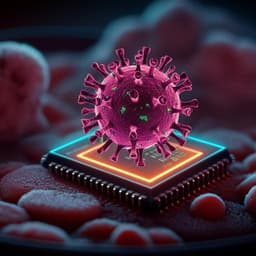
Engineering and Technology
Smart polarization and spectroscopic holography for real-time microplastics identification
Y. Zhu, Y. Li, et al.
Explore the groundbreaking SPLASH system developed by Yanmin Zhu, Yuxing Li, Jianqing Huang, and Edmund Y. Lam, which revolutionizes the identification of microplastics in real-time using advanced polarization and spectroscopic techniques, achieving impressive accuracy with machine learning.
~3 min • Beginner • English
Introduction
Microplastic particles are pervasive pollutants linked to adverse biological effects and growing environmental and climate concerns. Conventional optical microscopy (SEM, TEM) provides morphology and texture, but these cues can be confounded by weathering and aging. Spectroscopic methods (Raman, FT-IR) enable chemical identification but suffer from weak signals, long acquisition and processing times, and demanding sample preparation, limiting in situ and real-time monitoring. Non-contact modalities such as polarization imaging (capturing anisotropy/birefringence) and digital holography (capturing amplitude/phase for OPD and refractive index) offer alternative physical contrasts but prior implementations often require manual polarization configurations or yield features sensitive to environmental conditions. The study proposes SPLASH, a smart polarization and spectroscopic holography system that simultaneously records polarization, holographic, and texture information to infer molecular structure and composition without a physical spectrometer. The goal is accurate, efficient, and real-time identification of microplastics among diverse natural particles using integrated multi-dimensional features and machine learning.
Literature Review
Prior work in polarization imaging (PI) leverages changes in the polarization state induced by specimens (related to anisotropy and birefringence), but manual state configuration hinders real-time field use. Polarization cameras using division-of-focal-plane sensors and advanced reconstruction have shown promise (e.g., 3D HSI color space imaging, skylight polarization measurement), yet their spectral-function applications remain underexplored. Digital holography (DH) captures complex wavefields to retrieve morphology, optical path difference, and refractive index, and has been deployed as portable devices for in situ detection. However, reliance on single holographic features can be vulnerable to environmental variations. Bianco et al. used fractal parameters of holographic fingerprints for MP identification, but accuracy was limited by morphological variability and insufficient material-composition cues. Bianco et al. further used off-axis DH extracting size, shape, and phase jumps, though performance degraded in real-world or blurred conditions. Valentino et al. developed a polarization-sensitive holographic flow cytometer to classify fibers (e.g., PA6, PA6.6, PET, PP, cotton, wool), requiring polarization-sensitive recording materials and orthogonally polarized waves; applicability to broader natural particulates was not demonstrated. Compared to such systems, SPLASH avoids orthogonally polarized sources, reduces components, and aims to integrate polarization and holography to yield robust, composition-related fingerprints.
Methodology
System design: SPLASH employs a compact optical setup with a 532 nm laser diode producing unpolarized light, collimated by a convex lens. A linear polarizer combined with a quarter-wave plate adjusts intensity without introducing phase modulation, producing uniformly distributed circularly polarized illumination. The sample modulates the wavefront, which is recorded by a polarization camera (Crevis MG-A500P-22, monochrome, 2464×2056 sensor, 3.45 µm pixels). A full Stokes polarization mask (PSM/SPM) is mounted before the sensor to simultaneously capture four polarization states (0°, 45°, 90°, 135°; Stokes S0–S3) in one shot. The recorded hologram spatial resolution is 1232×1028 pixels; smallest detectable particle size is ~20 µm. Continuous recording enables real-time acquisition, with ~2 ms per data group, and the simplified optics eliminate manual polarizer adjustments and reduce aberration.
Data and specimens: The dataset comprises 3221 images (size 1028×1232 each) across classes: PC (518), PET (240), PP (232), PVC (535), PMMA (573), Chlorella (208), Daphnia magna (126), and young root of plant T.S. (789). MPs (PVC, PP, PS, PC, PET, PMMA) are 1–3 mm. Natural specimens include young root of plant T.S., Chlorella spp., and Daphnia magna cultured under controlled conditions.
Feature extraction: Multi-dimensional features are computed from SPLASH images:
- Polarization features: angle of polarization (AoP), degree of linear polarization (DoLP), phase retardation, optical axis orientation.
- Holographic features: fringe contrast and transparency descriptors of interference patterns.
- Texture features: neighborhood gray-tone difference matrix (NGTDM) metrics (coarseness, contrast, busyness, complexity, strength) and gray-level size zone matrix (GLSZM) metrics (e.g., small/large zone emphasis, zone size entropy, non-uniformity).
- Fourier power spectrum (FPS) features: radial summation and angular summation characteristics.
Correlation analyses (Pearson) and violin plots assess feature relationships and distributions across materials.
Classification and evaluation: Machine learning classifiers include ensemble subspace discriminant (ESD), k-nearest neighbors (KNN), neural network (NN), and support vector machine (SVM). Five-fold cross-validation and repeated training are employed; ROC and AUC are computed (500 repeated trainings for SVM ROC reported). Single-category features and a combined feature set (weighted 4:2:2:2 for polarization:holographic:texture:FPS based on single-feature performance) are evaluated. Additional qualitative discrimination experiments use AoP maps for MPs mixed with natural particles (Chlorella, Daphnia magna, plant roots) in aquatic/airborne environments.
Key Findings
- SPLASH simultaneously captures four polarization states, combining polarization, holographic, and texture information without a physical spectrometer, enabling real-time acquisition (~2 ms per dataset) with spatial resolution 1232×1028 and minimum detectable particle size ~20 µm.
- Feature correlations: Polarization features (optical axis orientation, phase retardation, AoP) show positive correlations with texture, holographic, and FPS features; DoLP exhibits negative correlation with parts of texture features (likely thickness-related). Transparency shows relatively strong negative correlation with other groups.
- Variability: Polarization and holographic features display smaller variances than texture/FPS; texture features (e.g., coarseness, strength, small zone emphasis, zone size non-uniformity) can show similar distributions across materials, limiting discriminatory power.
- Classification performance (AUC): Texture and FPS features alone yield AUCs ~0.6–0.7 across classifiers; holographic features yield ~0.63–0.7. Polarization features markedly improve performance, reaching ~0.8 AUC. Combined multi-dimensional features (weighted 4:2:2:2) achieve best overall AUCs: 0.85 (ESD), 0.83 (KNN), 0.81 (NN), 0.805 (SVM), with variances <0.05.
- Robust discrimination demonstrated among MPs (PC, PET, PMMA, PP, PVC, PS) and natural particles (young root of plant T.S., Chlorella, Daphnia magna). AoP maps provide qualitative separability reflecting molecular structural differences.
- System operational range demonstrated for particles approximately 0.6 mm–5 mm (specimen sizes 1–3 mm MPs used).
Discussion
The proposed SPLASH framework directly addresses the need for rapid, non-destructive, and reliable microplastic identification by integrating polarization and holographic cues that correlate with molecular structure and refractive properties, thereby compensating for the limitations of morphology-only or single-modality methods. The strong contribution of polarization features (AoP, phase retardation, optical axis orientation) and their low variance provide stable discriminants across MP categories, while holographic features add complementary structural information. Multi-dimensional feature fusion further enhances robustness, achieving AUCs ≥0.8 and up to 0.85 across classifiers, surpassing texture/FPS-only baselines (~0.6–0.7). Qualitative AoP visualizations validate separability of MPs from natural particulates (Chlorella, Daphnia magna, plant roots) in realistic aqueous/airborne contexts, indicating applicability to environmental monitoring. By removing the need for a physical spectrometer and manual polarization adjustments, SPLASH improves throughput and practicality for in situ detection, and offers a pathway to real-time, automated assessments of MP distributions and potential ecological impacts.
Conclusion
SPLASH introduces a compact, snapshot polarization-spectroscopic holography system that simultaneously captures four polarization states and holographic information, enabling spectroscopic-like material discrimination without a spectrometer. The method extracts rich, multi-dimensional features and, with ML classifiers, achieves robust MP identification (AUC up to 0.85) with low variance, outperforming texture- or FPS-only approaches. The system demonstrates reliable discrimination of MPs from natural particles and supports real-time operation. Future directions include: image descattering for turbid aquatic environments; development of high-throughput microfluidic systems for rapid, non-contact MP quantification; low-cost, compact, portable devices for field and underwater deployment; and broader applications to industrial and medical material analysis, including component identification and tissue diagnostics.
Limitations
- Environmental factors (e.g., water scattering/turbidity) can degrade image quality; image descattering is needed for robust aquatic deployments.
- Texture features are sensitive to weathering and aging, limiting their standalone discriminative power; DoLP may fluctuate with specimen thickness.
- Holographic features can be affected by environmental changes or blurring in real-world conditions.
- Demonstrated detection/size ranges may limit very small particles beyond the ~20 µm minimum detectable and 0.6–5 mm system demonstration range.
- While effective for studied classes, broader generalization to a wider variety of natural particulates and complex mixtures may require further validation and model adaptation.
Related Publications
Explore these studies to deepen your understanding of the subject.







